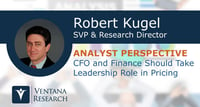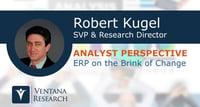Anaplan recently held Anaplan Hub, its annual user group meeting. The company offers a cloud-based business planning platform that incorporates a modeling and calculation engine. The tool makes it relatively easy to add or expand the scope of plans that can be connected and monitored as a central source. Companies typically use Anaplan software for financial planning or budgeting, sales, workforce, marketing and IT planning. These are the types of plans in which companies often need to create...
Read More
Topics:
Customer Analytics,
Human Capital Management,
Marketing,
Marketing Performance Management,
Office of Finance,
Recurring Revenue,
Continuous Planning,
Analytics,
Business Intelligence,
Cloud Computing,
Collaboration,
HRMS,
Sales Performance Management,
Workforce Management,
Financial Performance Management,
Price and Revenue Management,
Work and Resource Management,
Operations & Supply Chain,
Sales Enablement and Execution,
ERP and Continuous Accounting,
Sales Planning and Analytics
Pricing is an issue that affects almost every for-profit company that doesn’t sell purely commodity products. A corporation’s approach to pricing can range from highly disciplined to ad hoc and from fully centralized to decentralized. The issue of centralized or decentralized depends a great deal on the markets the company serves, its organizational structure and its culture. However, a disciplined approach to price setting and negotiation is always superior to an ad hoc approach. This is...
Read More
Topics:
Big Data,
Office of Finance,
Continuous Planning,
Analytics,
Sales Performance Management,
Financial Performance Management,
Price and Revenue Management,
Pricing and Promotion Management,
Sales Enablement and Execution,
ERP and Continuous Accounting,
Sales Planning and Analytics
Oracle recently held its second ERP Cloud Summit with industry analysts. The all-day event wasn’t just about ERP. The company covered a range of its business applications, including financial performance management as well as its Adaptive Intelligent Applications. And it wasn’t just about the cloud. After more than a decade of steady developments, ERP systems have begun to change fundamentally, facilitated by the growing availability of new technologies including cloud computing, advanced...
Read More
Topics:
Big Data,
Data Science,
Mobile,
Customer Experience,
Human Capital Management,
Machine Learning,
Office of Finance,
Analytics,
Data Integration,
Internet of Things,
Cognitive Computing,
HRMS,
Financial Performance Management,
Mobile Marketing Digital Commerce,
Digital Marketing,
Digital Commerce,
Operations & Supply Chain,
Enterprise Resource Planning,
ERP and Continuous Accounting
Ventana Research recently announced the results of its latest Benchmark Research, Next-Generation ERP. The enterprise resource planning (ERP) system is at the core of nearly every company’s record-keeping and management of business processes. Its smooth and uninterrupted functioning is essential to an organization’s accounting and finance functions. In manufacturing and distribution, ERP manages inventory and logistics. Some companies use it to handle human resources functions like tracking...
Read More
Topics:
Big Data,
Mobile,
Human Capital Management,
Office of Finance,
Cloud Computing,
Collaboration,
Inventory Optimization,
Work and Resource Management,
Enterprise Resource Planning,
ERP and Continuous Accounting














